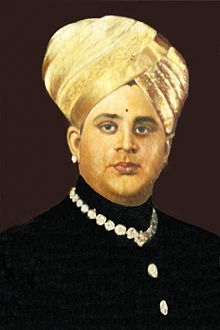| Jayachamarajendra Wadiyar | |
|---|---|
 | |
| 25th Maharaja of Mysore | |
| Reign | 3 August 1940 – 25 January 1950 |
| Coronation | 8 September 1940, Palace of Mysore |
| Predecessor | Krishnaraja Wadiyar IV |
| Successor | Srikantadatta Narasimharaja Wadiyar |
| Rajpramukh of Mysore State | |
| In office 26 January 1950 – 1 November 1956 | |
| Preceded by | Position Established |
| Succeeded by | Position Abolished |
| Governor of Mysore State | |
| In office 1 November 1956 – 4 May 1964 | |
| Preceded by | Position Established |
| Succeeded by | S M Srinagesh |
| Governor of Madras State | |
| In office 4 May 1964 – 28 June 1966 | |
| Preceded by | Bhishnuram Medhi |
| Succeeded by | Sardar Ujjal Singh |
| Born | 18 July 1919 Mysore Palace, Mysore, Mysore State, British India (present-day Karnataka, India) |
| Died | 23 September 1974 (aged 55)[1] Bangalore Palace, Bangalore, Karnataka, India |
| Spouse | Satya Prema Kumari (m. 1938, div. 1940) Tripura Sundari Ammani (m. 1942) |
| Issue |
|
| House | Wadiyar |
| Father | Yuvaraja Kanteerava Narasimharaja Wadiyar |
| Mother | Yuvarani Kempu Cheluvaja Amanni |
| Religion | Hinduism |
Jayachamarajendra Wadiyar (18 July 1919 – 23 September 1974), sometimes simply Jayachamaraja Wadiyar, was the twenty-fifth and last ruling Maharaja of Mysore, reigning from 1940 to 1950,[3] who later served as the governor of Mysore until 1964 and as governor of Madras from 1964 to 1966.
Wadiyar ascended the throne upon the sudden demise of his uncle Maharaja Krishnaraja Wadiyar IV. His reign as King began in 1940 during the onset of World War II in Europe and concluded with his merging the Kingdom into the Dominion of India in 1947 but continued as maharaja until India's constitution into a republic in 1950.[4] Kuvempu, his Kannada teacher and the vice-chancellor of Mysore University, remarked upon his ceding the kingdom: "Whereas kings have become so upon assuming thrones, he became a great king by renouncing one".[5] C. Hayavadana Rao, a noted historian, referred to the maharaja in the preface of his unfinished book as a "supporter of every good cause aiming at the moral and material progress of the people".[6]
- ^ "Jaya Wadiyar Bahadur Dies; Former Maharaja of Mysore". The New York Times. 24 September 1974. Page 53, columns 4-6. Retrieved 24 November 2023.
- ^ "Two members of erstwhile Mysore royal family die on final day of Dasara celebrations". 19 October 2018. Archived from the original on 19 October 2018.
- ^ "Remembering the Maharaja who was a maverick, a genius".
- ^ Schmidt, Karl J. (1995). An atlas and survey of South Asian history. M.E. Sharpe. p. 78. ISBN 978-1-56324-334-9.
Although the Indian states were alternately requested or forced into union with either India or Pakistan, the real death of princely India came when the Twenty-sixth Amendment Act (1971) abolished the princes' titles, privileges, and privy purses.
- ^ "'Elected representatives neglecting Wadiyars'". Deccan Herald. 18 July 2018. Retrieved 11 February 2023.
- ^ Rao, Hayavadana (1943). History of Mysore (PDF). pp. i.